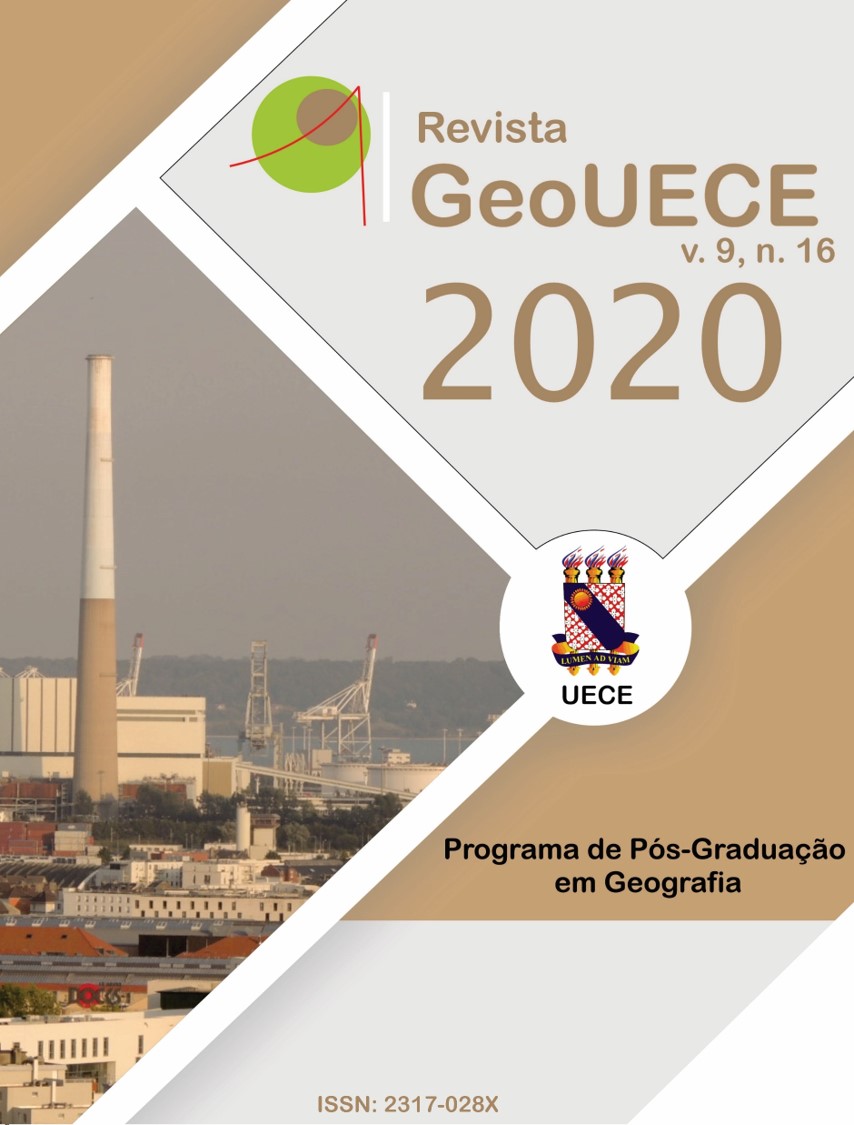Vol. 9 No. 16 (2020)

EDITORIAL
In this moment of multiple resistances and hopes for the present - future, the GeoUECE Magazine of the Geography Posgraduate Program at the State University of Ceará (PropGeo / UECE), presents volume 9, number 16, January-June 2020 edition.
In addition to the qualified works published in this issue, we would like to make public that the magazine has undergone constant changes in its form and content. In this issue, the readers will have the opportunity to check the innovations carried out in partnership with the new members of the Editorial Council, they are: development of a new layout; revision of the rules of publication and creation of the session “pedagogical experiences”. The new session was created, as we understand that the works produced in the most varied teaching, research and extension experiences can be socialized as a possibility of learning and building a multiple science. Also as part of the changes, in addition to the formation of the Editorial Council, we also expanded our Scientific Council.
In turn, in volume 9, number 16 (Jan./Jun, 2020), we present a set of 12 articles written by highly qualified researchers and researchers, whose thematic, spatial and temporal cuts intertwine scales in order to present the methodological theoretical diversity of contemporary Geography.
The articles signed by the members of the Latin American Network of Studies on Space and Economics (RELAEE) published here, were discussed at the 3rd Annual Political Economy Meeting, organized by the Portuguese Political Economy Association (EcPol) and held in the city of Porto / Portugal, in January 2020, at the Portuguese Catholic University and at the Faculty of Economics of the University of Porto. In this context, the text of the authors Floriano Godinho de Oliveira and Leandro Dias de Oliveira, explain phenomena and processes that are configured by a myriad of agents involved in the “spatial circuit of oil production” that materialize in cities, generating, among others, fragmentation and socio-territorial inequalities. In continuity, the text by Maria Terezinha Serafim Gomes, aims to explain the role of the State in the formation of hybrid spaces for innovation in Brazilian medium-sized cities. To complete the triad of RELAEE articles, Regina Helena Tunes from a problematizing view of reality, addresses how economic geography allows to explain the industrial dynamics of Rio de Janeiro. In summary, the three texts show part of the great potential that this research network represents to read, from the perspective of political economy and economic geography, the recent dynamics of the territory. In this perspective, the works of Francisco Cortezzi “La circulation comercialle de l'açai brésilien (1999-2016): le reseau geografique international ses nœuds, ses flux et ses nouvelles forms de production et de reproduction dans l'espace” and the authors Marlon Cavalcante Santos; José Borzacchiello da Silva and Eciane Soares da Silva Bezerra entitled “Globalization and the urban space circuit of sewing: the clothing industry in Fortaleza-Ceará”
The dynamics of nature are present in a multiscale way in the works signed by Beatriz Sosa, Gabriela Fernandes and Marcel Achkar that analyze the “Relationship between the propagation of the invasive process of triacanthos gieditsia and the deposition of arena in bosques del rio Uruguay”; also by Thais Ferreira da Conceição; Miguel da Guia Albuquerque; Jean Marcel de Almeida Espinoza, we present the text that is concerned with investigating the “Use of the polygon method of change to characterize the behavior of the coast line of the peninsula of the municipality of Rio Grande / RS, between the years 2004 to 2018”; next, the debate about environmental changes with emphasis on the aspects of land use and occupation in Tocantins appears in the article written by Sandro Sidnei Vargas de Cristo and José Paulo da Silva Noleto. Then, the conflict that is also inherent to the appropriation of nature appears in the text signed by Cícero Bezerra da Silva, which is thus entitled “Conflicts over water and the (mis) paths of use and appropriation in the context of the semiarid”. Last but not least, the contributions of the works on the dynamics of nature are based on the concerns linked to the planning of areas with vegetation cover, as is the case of the work signed by Giovane de Oliveira Bonilha and Simone Emiko Sato, entitled “Analysis the temporal dynamics of land use and coverage as a subsidy to the planning of the municipality of Rio Grande-RS and the article “Pedogeomorphological characterization of an Arenosol-podzol transition in the Sapiranga Ecological Reserve, Mata de São João-BA.
The work entitled “The importance of field classes in the teaching and learning process of Geography, signed by Anderson Felipe Leite dos Santos and Maria Marta dos Santos Buriti, inaugurate the GeoUECE session entitled “Pedagogical Experiences”.
We thank the entire team of our magazine, the reviewers, authors and authors, while welcoming the new members of the editorial and scientific councils. Thank you for believing in collective construction!
Happy reading to the entire academic community!
Denise Cristina Bomtempo
Davis Pereira de Paula
Editorial Coordination of GeoUECE MAGAZINE
August 2020.
































